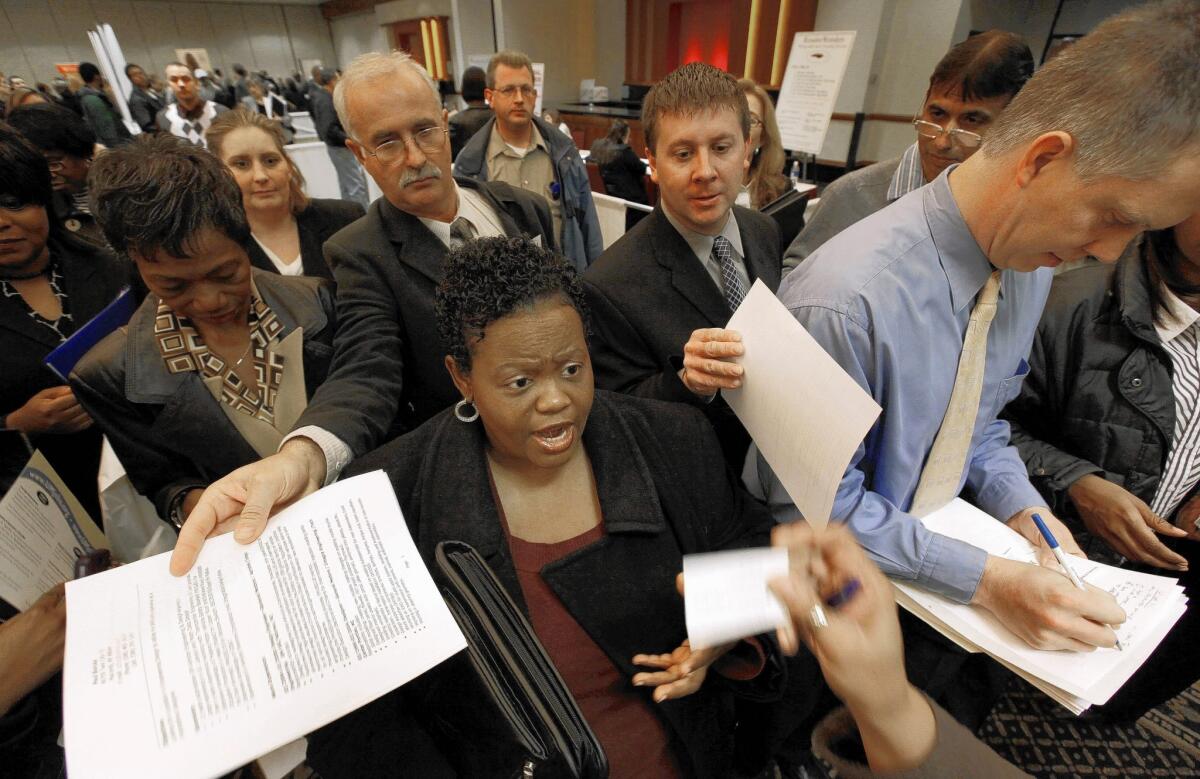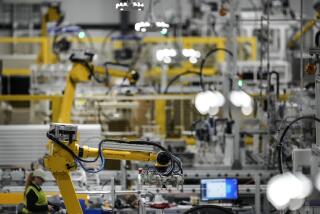5 years after the Great Recession: Where are we now?

- Share via
It was the worst U.S. economic calamity since the 1930s.
Over 19 months, the Great Recession erased trillions of dollars of wealth, destroyed 8 million jobs and robbed tens of thousands of their homes. More than half of adults lost a job or saw a cut in pay or hours, and almost everybody’s wealth fell.
In the five years since the recovery began, the economy has grown slowly, in fits and starts.
Millions of workers have remained unemployed for months, even years. Millions more, faced with huge drops in the value of their homes and uncertainty about future income, made radical changes in their plans and lifestyles. Seniors stayed in their jobs longer; young adults cocooned in their parents’ basements.
Even the good news has been tinged with bad: People are saving more, and consumers have cut back use of credit cards. Both trends are good for individuals’ long-term financial well-being, but not so good for the U.S. economy as a whole: Lower consumer spending means fewer customers for companies, fewer jobs for workers.
At the recovery’s five-year mark, here are things to keep in mind.
It’s not as bad as elsewhere in the world
It’s understandable that many Americans don’t feel much better off than five years ago. Unemployment seems stuck above 6%, most people have seen few or no raises. And the poverty rate remains the same or, by some accounts, has risen.
But from a global perspective, the picture looks very different.
Anemic as the U.S. recovery is, it’s much better than that of debt-flummoxed Europe or still-stagnant Japan. The United States is once again the locomotive of global growth.
Despite this winter’s doldrums, the U.S. economy is expected to outpace those of other major developed nations this year, including three of the world’s top five economies — Japan, Germany and France. None of them is projected to come close to matching American growth, which economists expect will be about 3% for the rest of this year and next.
“A meaningful rebound in U.S. economic activity is now underway, and we expect growth to exceed potential over the next few quarters,” Christine Lagarde, managing director of the International Monetary Fund, said this month.
China is likely to keep sprinting ahead as it closes in on supplanting the U.S. as the largest economy. But it started way behind economically, so big growth spurts are not unexpected.
With more than three times the population of the U.S., China has an income per person that is less than one-fifth of America’s $53,000. So it will be decades before the average Chinese citizen approaches a standard of living comparable to the typical American’s.
And the U.S. still has many competitive advantages, among them its large, expanding and comparatively youthful population. Unlike some rich countries, America isn’t suffering from a shrinking workforce. It continues to attract the best and brightest from all over, many to America’s best universities, which remain unrivaled.
U.S. spending for research and development rose 4.4% in 2011 to more than $429 billion, the latest National Science Foundation count shows. That’s 2.85% of the U.S. economy, little changed from its peak in the mid-1960s. The U.S. share of global R&D accounts for a world-leading 30% of all such investments.
A lot depends on where you live
From economist Stephen Levy’s view in Palo Alto, Calif., things today are as good as they were before the Great Recession, maybe better.
On a typically gorgeous May morning in the Bay Area, he woke up to find that the top newspaper headline was about businesses in San Francisco trying to find workers because unemployment there had fallen to a little above 4%. The next day, the front pages of local papers were splashed with photos of Google’s new driverless cars.
Living in Silicon Valley “is a huge plus,” Levy said.
Incomes have indeed jumped in technology-rich areas, as well as other highly educated centers such as Boston and Seattle. America’s energy boom, meanwhile, has knocked the jobless rate down to a mere 2.7% in North Dakota and helped re-invigorate Louisiana and other states along the Gulf Coast.
Meanwhile, cities such as Pittsburgh and Minneapolis that rely more on healthcare have sprung back relatively quickly, as have places with low housing and operating costs, particularly Texas and other parts of the South.
Things have been slower for folks along such industrial belts as Illinois and Michigan, even though carmakers have rebounded and other manufacturers are starting to make more of their products in the U.S.
Many areas still haven’t come back from the real estate collapse; unemployment remains in double digits through much of California’s Central Valley, for example, and reviving economies in Georgia and Arizona still have further to go.
The recession hit the housing-bubble economies of the West and South hardest, but now those states are again leading the way in migration and home building. And a familiar pattern is returning to bolster growth in those areas: Young people are escaping rural America for the city and older residents are settling in warmer climates.
If you’re rich, the recovery looks great
Household net worth — what you have, minus what you owe — rose to a record $81.7 trillion in the first quarter.
But that growth in wealth has not been even. Over the last five years, the rich got richer.
That’s because wealthier Americans are far more likely to own stocks, and household assets in equities have more than doubled since 2008 to $20.6 trillion earlier this year.
Moreover, for the wealthy, a downturn or a slow recovery can provide advantages: With real interest rates near zero, the price of assets — investment property, securities, luxury goods and so forth — remains relatively cheap.
But what about the rest of us?
The economy reached another milestone last month: All 8.7 million jobs lost in 2008 and 2009 have now been regained.
But while the nation’s payrolls are back to their previous high, they haven’t kept pace with growth in the working-age population over the last few years.
Moreover, many of the jobs lost have been replaced with lower-paying ones.
As of May, total employment in construction and manufacturing, where pay is relatively high, was down more than 3 million compared with before the recession.
By contrast, restaurants, temporary help firms and retail outlets have added 3 million jobs, making them three of the fastest-hiring industries during the recovery. But their average hourly pay ranges from $12.35 for restaurants to $16.96 for retail, compared with $24.72 for manufacturing and $26.59 for construction.
There have been robust job gains in healthcare, where workers in doctors’ offices typically earn more than $37.54 an hour, and in fields such as computer design, with average pay of $42.58.
But the share of middle-income jobs has been declining, reflecting a polarized labor market that puts little value on routine work but offers ever-bigger rewards to those with specialized knowledge and skills.
Also, for the average American, housing is the main source of wealth, and that market hasn’t grown much throughout most of the country. It still has a long way to go to recover the equity lost in the recession — almost $2 trillion without adjusting for inflation.
The median household net worth — the point at which half are above and half below — was about $74,000 in 2009 dollars, well below the level hit in the late 1990s when adjusted for inflation, according to calculations by Moody’s Analytics.
Young adults are a missing ingredient to the rebound
Tenbeete Solomon, 22, took her freshly minted business degree from the University of Maryland to Nordstrom for a commission-based sales job in the personal styling section.
Her fellow Maryland alumna Jillian Downing, an English major, has an administrative internship with the Federal Deposit Insurance Corp., which lasts only through September.
“It’s scary, the job market is scary,” says Downing, also 22.
Underemployment has become a vexing problem. Four out of 10 recent college graduates have jobs that typically do not require a bachelor’s degree, and many of the positions don’t pay much. And the job market is a lot worse for those without a bachelor’s degree.
The college class of 2014 is the most indebted ever, keeping many from going out on their own and helping boost a shortage of first-time home buyers.
If the past is any guide, the hard work and investment made by people like Solomon and Downing will eventually pay off, but underemployment among college graduates may stay very high.
The problem for college graduates began well before the Great Recession, around 2000, as employment demand stirred by the computer revolution started to wane. Specifically, there’s evidence of sharply curtailed opportunities for people in so-called cognitive-task occupations, those typically associated with college graduates.
“We’re not saying things came to an end in 2000,” said David Green, an economics professor at the University of British Columbia. But he noted that investment in software as a share of the economy rose strongly until the end of the millennium.
He and Canadian colleagues Paul Beaudry and Benjamin Sand have concluded that the declining fortunes of young adults could be linked to this broader slowdown, as each successive group of college graduates since 2000 has tended to show poorer results in cognitive employment and wage levels.
At Maryland’s commencement ceremony last month, Susan Taylor, 53, was thrilled to see her daughter earn her English degree at her alma mater. Her daughter doesn’t have a job yet and owes about $30,000 in college loans, near the national average.
“I realize it’s not the same situation now as when I graduated,” said Taylor, an elementary school teacher who remembers having no problem finding a job straight out of college.
We are still waiting for the Next Big Thing
Fracking. Driverless cars. 3-D printing. Robotics. Facebook.
Although all of these economically stimulating innovations represent American ingenuity, none has emerged as a game-changer for the economy in the way the Internet or the personal computer did.
Yet the hopes of many, even those who distrust the current economy and have little faith in government, rest on the development of these and other revolutionary technologies.
The most common refrain among optimists and politicians is that America can do it again because America has done it before.
While business start-ups have slowed and the Great Recession may have permanently lowered the growth potential for the U.S., many believe the nation still is the most likely economy in the world to spawn the next big thing.
America’s aging population and slowing labor force growth, combined with weaker capital investments during the recession in recent years, could undoubtedly curb the economy’s future performance. And the latest wave of social media applications has raised questions about what value they are creating for the broader economy, something captured in the credo at Paul Thiel’s venture capital firm: “We wanted flying cars, instead we got 140 characters.”
Even so, the information revolution and all its offshoots give experts excitement about more breakthroughs to come — if not innovative products, then new ways to tackle old problems.
“Am I on Facebook? No,” said Edward Glaeser, an economics professor at Harvard University. “But hundreds of millions of people use it, and one way to see value is how much time people are allocating to it.”
Moreover, he said, innovations in information technology are improving the flow of ideas, raising the possibility of more breakthroughs. “I don’t think history gives us much reason to be cynical.”
Who’s right is the crucial question. But we may reach the 10th anniversary of the Great Recession’s end before we know the answer.
More to Read
Inside the business of entertainment
The Wide Shot brings you news, analysis and insights on everything from streaming wars to production — and what it all means for the future.
You may occasionally receive promotional content from the Los Angeles Times.











